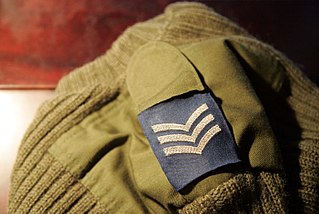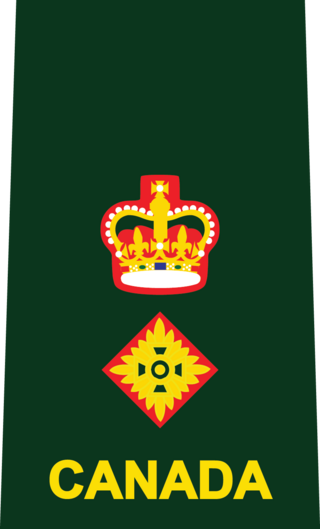A lieutenant is a junior commissioned officer rank in the armed forces of many nations, as well as fire services, emergency medical services, security services and police forces.
Lieutenant Commander is a commissioned officer rank in many navies. The rank is superior to a lieutenant and subordinate to a commander. The corresponding rank in most armies and air forces is major, and in the Royal Air Force and other Commonwealth air forces is squadron leader. It is roughly equivalent to the Corvette Captain rank in central European countries and the Captain 3rd rank rank in eastern European/CIS countries.
Second lieutenant is a junior commissioned officer military rank in many armed forces. The lowest officer rank, it is usually placed below lieutenant or first lieutenant.
Brigadier general or brigade general is a military rank used in many countries. The rank is usually above a colonel, and below a major general or divisional general. When appointed to a field command, a brigadier general is typically in command of a brigade consisting of around 4,000 troops.

An aide-de-camp is a personal assistant or secretary to a person of high rank, usually a senior military, police or government officer, or to a member of a royal family or a head of state.
This is a table of the ranks and insignia of the Canadian Armed Forces. As the Canadian Armed Forces is officially bilingual, the French language ranks are presented following the English.
The United States Air Force officer rank insignia in use today.
Ensign is a junior rank of a commissioned officer in the armed forces of some countries, normally in the infantry or navy. As the junior officer in an infantry regiment was traditionally the carrier of the regimental colours, the rank acquired the name. This rank has generally been replaced in army ranks by second lieutenant. Ensigns were generally the lowest-ranking commissioned officer, except where the rank of subaltern existed. In contrast, the Arab rank of ensign, لواء, liwa', derives from the command of units with an ensign, not the carrier of such a unit's ensign, and is today the equivalent of a major general.
Officer cadet is a rank held by military cadets during their training to become commissioned officers. In the United Kingdom, the rank is also used by members of University Royal Naval Units, University Officer Training Corps and University Air Squadron; however, these are not trainee officers with many not choosing a career in the armed forces.

Mess dress uniform is the most formal type of evening-wear uniform used by military personnel, police personnel, and other uniformed services members. It frequently consists of a mess jacket, trousers, white dress shirt and a black bow tie, along with orders and medals insignia. Design may depend on regiment or service branch, e.g. army, navy, air force, marines, etc. In modern Western dress codes, mess dress uniform is the supplementary alternative equivalent to the civilian black tie for evening wear. Mess dress uniforms are typically less formal than full dress uniform, but more formal than service dress uniform.
Colonel is a Canadian Forces rank used by commissioned officers who wear the army, air force or special operations uniform. Captain(N) is the equivalent rank for officers who wear the navy uniform. A colonel is senior to the army and air force rank of lieutenant-colonel or the naval rank of commander, and junior to the army and air force rank of brigadier-general or the naval rank of commodore.
Before Unification as the Canadian Armed Forces in 1968, the Canadian military had three distinct services: the Royal Canadian Navy, the Royal Canadian Air Force, and the Canadian Army. All three services had a Regular (full-time) component and a reserve (part-time) component. The rank structure for these services were based on the services of the British military, the Royal Navy, the Royal Air Force, and the British Army. The change to a "Canadian" rank structure meant that many of the traditional (British) rank titles and insignia were removed or changed.

Major is a rank of the Canadian Armed Forces for officers who wear the army or air force uniform. It is equivalent to the rank of lieutenant-commander for officers who wear the navy uniform, and is the lowest rank of senior officer. A major is senior to a captain and junior to a lieutenant-colonel.
The Indonesian National Armed Forces (TNI) uses a simplified ranking system for the three branches of Indonesian Army, Indonesian Navy and Indonesian Air Force. Most of the ranks are similar with differences for the rank titles of the high-ranking officers. Exception exists, however, in the ranks of the service members of the Indonesian Marine Corps. While Indonesian Marine Corps is a branch of the Navy, the rank titles of the Marine Corps are the same as those of the Army, but it still uses the Navy's style insignia.

A shoulder mark, also called a rank slide or slip-on, is a flat cloth sleeve worn on the shoulder strap of a uniform. It may bear rank or other insignia. A shoulder mark should not be confused with a shoulder board, a shoulder knot, or an epaulette, although these terms are often used interchangeably.

In the Canadian Forces, lieutenant-colonel is a rank for officers who wear army or air force uniform. It is equivalent to commander for officers who wear navy uniform and is the second-highest rank of senior officer. A lieutenant-colonel is senior to a major or lieutenant-commander, and junior to a colonel or naval captain.

Gorget patches are an insignia in the form of paired patches of cloth or metal on the collar of a uniform (gorget), used in the military and civil service in some countries. Collar tabs sign the military rank, the rank of civil service, the military unit, the office (department) or the branch of the armed forces and the arm of service.
In the Royal Canadian Navy, the rank of commander is a naval rank equal to a lieutenant-colonel of the army or air force. A commander is senior to a lieutenant-commander or an army or air force major, and junior to a captain or colonel.
In the Royal Canadian Navy, the rank of lieutenant-commander (LCdr) is the naval rank equal to major in the army or air force and is the first rank of senior officer. Lieutenant-commanders are senior to lieutenants (N) and to army and air force captains, and are junior to commanders and lieutenant colonels.
In the Royal Canadian Navy, the rank of lieutenant(N) (Lt(N)) (French: Lieutenant de vaisseau) is the naval rank equal to captain in the army or air force. When the naval rank lieutenant is written or typed, it is followed by the letter N to indicate that it is a naval rank to distinguish it from army and air force lieutenants (and therefore, the (N) remains silent as it must not be pronounced or replaced by the word (Navy)). Lieutenants(N) are senior to sub-lieutenants and to army and air force lieutenants, and are junior to lieutenant-commanders and majors.







